Geochronology/Cenozoic
< Geochronology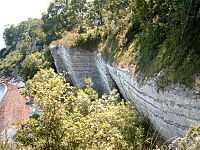
Geochronology/Cenozoic is the science of applying dates in the past to apparently Cenozoic rocks.
Notations
Let
- ALMA represent the Asian Land Mammal Age,
- b2k represent before AD 2000,
- BP represent before present, as the chart is for 2008, this may require an added -8 for b2k,
- ELMMZ represent the European Land Mammal Mega Zone,
- FAD represent first appearance datum,
- GICC05 represent Greenland Ice Core Chronology 2005,
- GRIP represent Greenland Ice Core Project,
- GSSP represent Global Stratotype Section and Point,
- ICS represent the International Commission on Stratigraphy,
- IUGS represent the International Union of Geological Sciences,
- LAD represent last appearance datum,
- Ma represent Megaannum, or million years ago, or -106 b2k,
- NALMA represent the North American Land Mammal Age,
- NGRIP represent North Greenland Ice Core Project, and
- SALMA represent South American Land Mammal Age.
"The term b2 k [b2k] refers to the ice-core zero age of AD 2000; note that this is 50 years different from the zero yr for radiocarbon, which is AD 1950 [...]."[1]
Cenozoic time frames
| Name (English)[2] | base/start (Ma)[3] | top/end (Ma)[3] | status | subdivision of | usage | named after | author, year |
|---|---|---|---|---|---|---|---|
| Aftonian | 0.6 | 0.48 | age | Pleistocene | North America | ||
| Agenian | 23 | 20.4 | ELMMZ | Miocene | Europe | Agen (France) | |
| Alding(i)an | 36 | 30 | age | Eocene | Australia | ||
| Allerød | 13,350 BP | 12,700 BP | chronozone | Weichselian | Northern Europe | Allerød (Denmark) | |
| Altonian | 19.0 | 15.9 | age | Miocene | New Zealand | Alton | |
| Amstelian | 2.588 | 2.40 | super-age | Pleistocene | Netherlands | river Amstel | Harmer, 1896 |
| Anglian | 0.465 | 0.418 | age | Pleistocene | Great Britain | East Anglia | |
| Antian | ~2.12 | ~2.0 | age | Pleistocene | Great Britain | River Ant (England) | |
| Antwerpian | ± 21 | ± 12 | age | Miocene | Belgium (obsolete) | Antwerp | Gogels, 1879 |
| Aquatraversian | 2.588 | 2.4 | age | Pleistocene | Italy | ||
| Aquitanian | 23.03 | 20.43 | age | Miocene | ICS | Aquitaine | |
| Archean | none | 2,500 | eon | Precambrian | ICS | ||
| Arikareean | 30.8 | 20.6 | super-age | Oligocene-Miocene | North America | ||
| Arnold | 43.0 | 34.3 | epoch | Paleogene | New Zealand | Arnold River | |
| Arshantan | 52.1 | 46.2 | ALMA | Eocene | Asia | ||
| Astaracian | 15 | 11.1 | ELMMZ | Miocene | Europe | The Astarac (France) | |
| Atlantic | 5,660 BP | 9,220 BP | chronozone | Holocene | Northern Europe | the Atlantic Ocean | Blytt, 1876 |
| Avernian | 29.2 | 23.03 | ELMMZ | Oligocene | Europe | ||
| Awamoan | 20.0 | 17.5 | age | Miocene | New Zealand | ||
| Azoic | eon | Precambrian | |||||
| Badenian[4] | 16.3 | 12.8 | age | Miocene | Paratethys | Baden (Austria) | Papp & Cicha, 1968 |
| Bairnsdalian | 15.0 | 10.5 | age | Miocene | Australia | ||
| Balcombian | 15.5 | 15.0 | age | Miocene | Australia | ||
| Barstovian | 16.3 | 13.6 | age | Miocene | North America | ||
| Bartonian | 37.2 ± 0.1 | 40.4 ± 0.2 | age | Eocene | ICS | Barton-on-Sea (South England) | Mayer-Eymar, 1857 |
| Batesfordian | 16.5 | 15.5 | age | Miocene | Australia | ||
| Bavel Interglacial | 1.03 | 0.96 | age | Pleistocene | Netherlands | Bavel | |
| Bavelian | 1.03 | 0.85 | super-age | Pleistocene | Netherlands | Bavel | |
| Baventian | ~2.0 | ~1.87 | age | Pleistocene | Great Britain | Easton Bavents (England) | West, 1961 |
| Beestonian | 1.77 | ~0.8 | age | Pleistocene | Great Britain | Beeston, Norfolk (England) | |
| Belvédère Interglacial | 0.338 | 0.324 | age | Pleistocene | Netherlands | quarry "Belvédère" (Maastricht) | |
| Biber Glacial | ~2.5 | 2.35 | age | Pleistocene | Alps | river Biber (Germany) | |
| Biber-Donau | age | Pleistocene | Alps | ||||
| Blancan | 4.9 | 1.8 | age | Pliocene-Pleistocene | North America | ||
| Bolderian | <21 | >16 | age | Miocene | Belgium (obsolete) | Bolderberg | Dumont, 1850 |
| Bølling | 13,730 BP | 13,480 BP | chronozone | Weichselian | Northern Europe | Bølling Sø (Denmark) | |
| Boreal | 10,640 BP | 9,220 BP | chronozone | Holocene | Northern Europe | boreal zone in ecology | Blytt, 1876 |
| Bortonian | 43.0 | 37.0 | age | Eocene | New Zealand | Bortons | |
| Bramertonian | ~2.12 | ~2.0 | age | Pleistocene | Great Britain | Bramerton Pits (England) | Funnell, Norton, West and Mayhew, 1979 |
| Bridgerian | 50.3 | 46.2 | age | Eocene | North America | ||
| Brüggenian | 2.588 | 2.4 | chronozone | Pleistocene | Northwest Europe | ||
| Brunssumian | 5.3 | 3.6 | chronozone | Pliocene | Northwest Europe | Brunssum (The Netherlands) | |
| Bulitian | 55.8 | 53 | age | Eocene | California | ||
| Bumbanian | 55.7 | 52.1 | ALMA | Eocene | Asia | ||
| Burdigalian | 20.43 | 15.97 | age | Miocene | ICS | Latin: Burdigala = Bordeaux (France) | Depéret, 1892 |
| Calabrian | 1.806 | 0.781 | age | Pleistocene | Southern Europe | Calabria | |
| Casamajoran | 54 | 48 | age | Eocene | South America | ||
| Cassian | 1.1 | 0.8 | age | Pleistocene | Italy | ||
| Castlecliffian | 1.63 | 0.34 | age | Pleistocene | New Zealand | Castlecliff | |
| Cenozoic | 65.5 ± 0.3 | present | era | Phanerozoic | ICS | new life | Phillips, 1847 |
| Cernaysian | 55.9 | 55.0 | ELMMZ | Paleocene | Europe | ||
| Chadronian | 38.0 | 33.9 | age | Eocene | North America | ||
| Chapadmalalan | 4.0 | 3.0 | age | Pliocene | South America | ||
| Chasicoan | 10.0 | 9.0 | age | Miocene | South America | ||
| Chattian | 28.4 ± 0.1 | 23.03 | age | Oligocene | ICS | Chatti (ancient Germanic tribe) | Fuchs, 1894 |
| Cheltenhamian | 5.0 | 4.3 | age | Pliocene | Australia | ||
| Clarendonian | 13.6 | 10.3 | age | Miocene | North America | ||
| Clarkforkian | 56.8 | 55.4 | age | Paleocene-Eocene | North America | ||
| Clifdenian | 15.9 | 15.1 | age | Miocene | New Zealand | Clifden | |
| Colhuehuapian | 21.0 | 17.5 | age | Miocene | South America | ||
| Colloncurian | 15.5 | 12.0 | age | Miocene | South America | ||
| Cromerian | 0.85 | 0.465 | super-age/age | Pleistocene | Netherlands, Great Britain | Cromer (England) | |
| Dacian | 5.332 ± 0.005 | 3.600 ± 0.005 | age | Pliocene | Paratethys | Dacia (Roman province) | |
| Danian | 65.5 ± 0.3 | 61.7 ± 0.2 | age | Paleocene | ICS | Denmark | Desor, 1847 |
| Dannevirke | 65.0 | 43.0 | epoch | Paleogene | New Zealand | Dannevirke | |
| Delmontian | 7.5 | 2.9 | age | Pliocene-Miocene | California | ||
| Deseadan | 29.0 | 21.0 | age | Oligocene-Miocene | South America | ||
| Deurnian | age | Miocene | Belgium (obsolete) | Deurne | de Heinzelin (1955) | ||
| Devensian | 0.116 | 0.0115 | age | Pleistocene | Great Britain | Devenses, Celtic tribe by the Deva (England and Wales) | |
| Divisaderan | 42 | 36 | age | Eocene | South America | ||
| Donau Glacial | 1.7 | 1.35 | age | Pleistocene | Alps | river Danube | |
| Donau-Günz | >2.35 | age | Pleistocene | Alps | |||
| Drenthian | 0.238 | 0.17 | chronozone | Pleistocene | Northwest Europe | Drenthe | |
| Duchesnean | 42.0 | 38.0 | age | Eocene | North America | ||
| Duntroonian | 27.3 | 25.2 | age | Oligocene | New Zealand | Duntroon | |
| Eburonian | 1.80 | 1.45 | super-age | Pleistocene | Netherlands | Eburones, Germanic tribe | |
| Eemian | 0.130 | 0.116 | age | Pleistocene | Northern Europe | river Eem (Netherlands) | Harting, 1875 |
| Egerian | 25.8 | 20.3 | age | Oligocene-Miocene | Paratethys | Eger (Hungary) | Báldi & Seneš, 1968 |
| Eggenburgian | 20.8 | 18.3 | age | Miocene | Paratethys | Eggenburg (Austria) | Steininger & Seneš, 1968 |
| Elsterian | 0.465 | 0.418 | age | Pleistocene | Northern Europe | river Weißen Elster (Germany) | |
| Emilian | 1.5 | 0.781 | sub-age | Pleistocene | Italy | ||
| Ensenadan | 1.2 | 0.8 | SALMA | Pleistocene | South America | ||
| Eocene | 55.8 ± 0.2 | 33.9 ± 0.1 | epoch | Paleogene | ICS | earliest recent | Lyell, 1847 |
| Ergilian | 35.1 | 33.8 | ALMA | Oligocene-Eocene | Asia | ||
| Flaminian | 0.5 | 0.3 | age | Pleistocene | Italy | ||
| Flandrian | 0.01 | present | age | Holocene | Western Europe (obsolete) | Flanders | Rutot & Van den Broeck, 1885 |
| Friasian | 16.3 | 15.5 | age | Miocene | South America | ||
| Fujian | 11.1 | 9.5 | age | Miocene | Japan | ||
| Gashatan | 56.9 | 55.7 | ALMA | Paleocene-Eocene | Asia | ||
| Geiseltalian | 48.5 | 42.7 | ELMMZ | Eocene | Europe | ||
| Gelasian | 2.588 | 1.806 | age | Pleistocene | ICS | Gela (Italy) | Rio et al., 1998 |
| Geringian | 30.8 | 26.3 | age | Oligocene | North America | ||
| Gramian | 10.3 | 8.5 | age | Miocene | Northern Germany | ||
| Grauvian | 50.8 | 48.5 | ELMMZ | Eocene | Europe | ||
| Günz Glacial | 2.35 | age | Pleistocene | Alps | river Günz (Germany) | ||
| Günz-Mindel | age | Pleistocene | Alps | ||||
| Hallian | ~10.000 | 0 | age | Holocene | California | ||
| Haranoyan | 18.2 | 15.97 | age | Miocene | Japan | ||
| Harrisonian | 24.8 | 20.6 | age | Oligocene-Miocene | North America | ||
| Hautawan | 3.1 | 2.2 | sub-age | Pliocene-Pleistocene | New Zealand | ||
| Haweran | 0.01 | present | age | Holocene | New Zealand | ||
| Headonian | 37.2 | 33.8 | ELMMZ | Oligocene-Eocene | Europe | ||
| Hemingfordian | 20.6 | 16.3 | age | Miocene | North America | ||
| Hemmoorian | age | Miocene | Northern Germany | ||||
| Hemphillian | 10.3 | 4.9 | age | Miocene-Pliocene | North America | ||
| Heretaungan | 49.5 | 46.2 | age | Eocene | New Zealand | ||
| Holocene | 11,800 BP | present | epoch | Quaternary | ICS | Greek: totally new | Gervais, 1867 |
| Holsteinian | 0.418 | 0.386 | age | Pleistocene | Northern Europe | Holstein (Germany) | |
| Houldjinian | 37.2 | 33.9 | ALMA | Asia | |||
| Houthalenian | <21 | >16 | age | Miocene | Belgium (obsolete) | Houthalen | Hirsch, 1952 |
| Hoxnian | 0.418 | 0.386 | age | Pleistocene | Great Britain | Hoxne (Suffolk) | West & Donner, 1956 |
| Hsandgolian | 33.8 | 24.0 | ALMA | Oligocene | Asia | ||
| Huayquerian | 9.0 | 6.8 | age | Miocene | South America | ||
| Hutchinsonian | 21 | 20 | age | Miocene | New Zealand | ||
| Icenian | 2.4 | ~2 | age | Pleistocene | Netherlands, England (obsolete) | Iceni, ancient tribe (England) | Pannekoek, 1956 |
| Ilfordian | age | Pleistocene | British Isles | Ilford (England) | |||
| Illinoian | 0.17 | 0.125 | age | Pleistocene | North America | ||
| Ionian | 0.781 | 0.126 | age | Pleistocene | Southern Europe | Ionian Sea (between Greece and Italy) | |
| Ipswichian | 0.130 | 0.116 | age | Pleistocene | Great Britain | Ipswich (England) | West, 1957 |
| Irdinmanhan | 46.2 | 40.4 | ALMA | Eocene | Asia | ||
| Irvingtonian | 1.8 | NALMA | Pleistocene | North America | Irvington | ||
| Itaboraian | 59 | 57 | age | Paleocene | South America | ||
| Jacksonian | age | Eocene | southern US | ||||
| Janjukian | 30.0 | 27.5 | age | Oligocene | Australia | ||
| Johannian | 48 | 35 | age | Eocene | Australia | ||
| Kaburan | 13.5 | 11.1 | age | Miocene | Japan | ||
| Kaiatan | 37.0 | 36.0 | age | Eocene | New Zealand | ||
| Kalimnan | 4.3 | 3.4 | age | Pliocene | Australia | ||
| Kansan | 0.48 | 0.26 | age | Pleistocene | North America | ||
| Kapitean | 6.5 | 5.0 | age | Miocene | New Zealand | ||
| Karpatian | 17.0 | 16.0 | age | Miocene | Paratethys | the Carpathian Mountains | Cicha et al., 1967 |
| Kasterlian | ~4.7 | ~3.6 | age | Pliocene | Belgium (obsolete) | Kasterlee | Dumont, 1882 |
| Kattendijkian | ~5 | ~3.6 | age | Pliocene | Belgium (obsolete) | Kattendijke | Glibert & de Heinzelin, 1957 |
| Kechienjian | 1.9 | 1.5 | age | Pleistocene | Japan | ||
| Kiscellian | 25.8 | age | Oligocene | Paratethys | |||
| Kryzhanovan | 1.9 | 1.2 | age | Pleistocene | Eastern Europe | ||
| Landenian | <60 | >55 | age | Paleocene | Western Europe (obsolete) | Landen (Belgium) | Dumont, 1839 |
| Landon | 34.3 | 21.7 | epoch | Paleogene-Neogene | New Zealand | ||
| Langenfeldian | age | Miocene | Northern Germany | ||||
| Langhian | 15.97 | 13.65 | age | Miocene | ICS | Serravalle Langhe (Italy) | Pareto, 1864 |
| Latdorfian | age | Oligocene | Germany | ||||
| Laventan | 13.8 | 12.0 | age | Miocene | South America | ||
| Likhvinian | 0.3 | 0.18 | age | Pleistocene | Eastern Europe | ||
| Lillburnian | 15.1 | 12.7 | age | Miocene | New Zealand | ||
| Lishihhuangtuan | 1.2 | 0.1 | age | Pleistocene | China | ||
| Longfordian | 27.5 | 16.5 | age | Oligocene-Miocene | Australia | ||
| Ludhamian | ~2.52 | ~2.25 | age | Pleistocene | Great Britain | Ludham (England) | |
| Ludian | age | Eocene | western Europe | de Lapparent, 1893 | |||
| Luisian | 15.5 | 13.5 | age | Miocene | California | ||
| Lujanian | 0.8 | 0.3 | age | Pleistocene | South America | ||
| Lutetian | 48.6 ± 0.2 | 40.4 ± 0.2 | age | Eocene | ICS | Latin: Lutetia=Paris (France) | de Lapparent, 1883 |
| Malanghuangtuan | 0.1 | 0.01 | age | Pleistocene | China | ||
| Mangaorapan | 53.0 | 49.5 | age | Eocene | New Zealand | ||
| Mangapanian | 3.00 | 2.40 | age | Pliocene-Pleistocene | New Zealand | ||
| Marahuan | 2.2 | 1.8 | sub-age | Pleistocene | New Zealand | ||
| Mayoian | 12.0 | 10.0 | age | Miocene | South America | ||
| Menapian | 1.03 | super-age | Pleistocene | Netherlands | Menapii, Germanic tribe | ||
| Merksemian | ~2.5 | ~2 | age | Pleistocene | Belgium (obsolete) | Merksem | de Heinzelin, 1958 |
| Mesozoic | 251.0 ± 0.7 | 65.5 ± 0.3 | era | ICS | middle life | ||
| Messinian | 7.246 | 5.332 | age | Miocene | ICS | Messina (Italy) | Mayer-Eymar, 1867 |
| Mindel | 0.85 | 0.465 | age | Pleistocene | Alps | river Mindel (Germany) | |
| Mindel-Riss | 0.465 | 0.238 | age | Pleistocene | Alps | ||
| Miocene | 23.03 | 5.332 | epoch | Neogene | ICS | Greek: less recent | Lyell, 1847 |
| Mitchellian | 10.5 | 5.0 | age | Pliocene-Miocene | Australia | ||
| Mohnian | 13.5 | 7.5 | age | Miocene | California | ||
| Monroecreekian | 26.3 | 24.8 | age | Oligocene | North America | Monroe Creek | |
| Montehermosan | 6.8 | 4.0 | age | Pliocene-Miocene | South America | ||
| Montian | ~65 | ~61 | age | Paleocene | Europe (obsolete) | Mons (Belgium) | Dewalque, 1868 |
| Morozovan | 0.8 | 0.5 | age | Pleistocene | Eastern Europe | ||
| Mustersan | 48 | 42 | age | Eocene | South America | ||
| Nanzian | 48 | 35 | age | Eocene | California | ||
| Nebraskian | 0.93 | 0.6 | age | Pleistocene | North America (obsolete) | ||
| Needian | 0.42 | 0.38 | age | Pleistocene | Netherlands (obsolete) | Neede | |
| Neocomian | 145.5 | 125.0/130.0 | epoch | obsolete | Neocomium, Latin name for Neuchâtel | ||
| Neogene | 23.0 | 2.588 | period | Cenozoic | ICS | Hoernes, 1856 | |
| Neporatan | 2.5 | 1.7 | age | Pleistocene | Eastern Europe | ||
| Neustrian | 55.0 | 50.8 | ELMMZ | Paleocene-Eocene | Europe | ||
| Nomentanan | 0.24 | 0.13 | age | Pleistocene | Italy | ||
| Nongshanian | 62.9 | 56.9 | ALMA | Paleocene | Asia | ||
| Nukumaruan | 3.1 | 1.8 | age | Pleistocene | New Zealand | ||
| Odessan | 1.2 | 0.8 | age | Pleistocene | Eastern Europe | ||
| Okehuan | 1.1 | 0.37 | age | Pleistocene | New Zealand | ||
| Older Dryas | 13,480 BP | 13,350 BP | chron | Weichselian | Europe | Dryas octopetala (plant) | |
| Oldest Dryas | 13,860 | 13,780 | chron | Weichselian | Europe | Dryas octopetala (plant) | |
| Oligocene | 33.9 ± 0.1 | 23.03 | epoch | Paleogene | ICS | "not so recent" | Beyrich, 1857 |
| Oostermeer Interglacial | 0.243 | 0.238 | age | Pleistocene | Netherlands | Oostermeer | |
| Opoitian | 5.0 | 3.8 | age | Pliocene | New Zealand | ||
| Orellan | 33.9 | 33.3 | age | Oligocene | North America | ||
| Orleanian | 20.4 | 15 | ELMMZ | Miocene | Europe | Orléans (France) | |
| Otaian | 21.7 | 19.0 | age | Miocene | New Zealand | ||
| Ottnangian | 18.3 | 17.0 | age | Miocene | Paratethys | Ottnang am Hausruck (Austria) | Papp & Rögl, 1967 |
| Paleocene | 65.5 ± 0.3 | 55.8 ± 0.2 | epoch | Paleogene | ICS | oldest recent | Schimper, 1847 |
| Paleophytic | ~450 | ~270 | era | paleobotany | old flora | ||
| Paleogene | 65.5 ± 0.3 | 23.0 | period | Cenozoic | ICS | Hoernes, 1856 | |
| Paleozoic | 542.0 ± 1.0 | 251.0 ± 0.7 | era | Phanerozoic | ICS | old life | |
| Pannonian | 11.608 ± 0.005 | 7.246 ± 0.005 | age | Miocene | Paratethys | Pannonia (Roman province) | Roth von Telegd, 1879 |
| Pareora | 21.7 | 15.9 | epoch | Neogene | New Zealand | ||
| Pastonian | ~1.87 | 1.77 | age | Pleistocene | Great Britain | Paston, Norfolk (England) | |
| Peligran | 62.5 | 59 | age | Paleocene | South America | ||
| Penutian | 53 | 51 | age | Eocene | California | ||
| Phanerozoic | 542.0 ± 1.0 | present | eon | ICS | visible life | ||
| Piacenzian | 3.600 | 2.588 | age | Pliocene | ICS | Piacenza (Italy) | Mayer-Eymar, 1858 |
| Pleistocene | 2.588 | 0.0117 | epoch | Quaternary | ICS | youngest recent | |
| Pleniglacial | 73,000 BP | 14,500 BP | sub-age | Pleistocene | Northern Europe | ||
| Pliocene | 5.332 | 2.588 | epoch | Neogene | ICS | newer recent | Lyell, 1847 |
| Poederlian | ~3.5 | ~2.5 | age | Pliocene | Belgium (obsolete) | Poederlee | Vincent, 1889 |
| Pontian | 7.246 ± 0.005 | 5.332 ± 0.005 | epoch | Miocene | Paratethys | Pontus Euxinus, Latin name for the Black Sea | Le Play, 1842 |
| Pontinian | 0.1 | 0.01 | age | Pleistocene | Italy | ||
| Porangan | 46.2 | 43.0 | age | Eocene | New Zealand | ||
| Preboreal | 11,560 BP | 10,640 BP | chron | Northern Europe | before the Boreal | ||
| Precambrian | none | 542.0 ± 1.0 | none (before: eon) | worldwide | before the Cambrian | ||
| Pre-Illinoian | age | Pleistocene | North America | before the Illinoian | |||
| Preludhamian | ~2.52 | ~2.61 | age | Pliocene-Pleistocene | Great Britain | before the Ludhamian | |
| Prepastonian | ~2.0 | ~1.87 | age | Pleistocene | Great Britain | before the Pastonian | |
| Pretiglian | 2.588 | 2.40 | super-age | Pleistocene | Netherlands | before the Tiglian Tegelen (The Netherlands) | Van der Vlerk, 1948 |
| Priabonian | 37.2 ± 0.1 | 33.9 ± 0.1 | age | Eocene | ICS | Priabona (Italy) | Munier-Chalmas & De Lapparent, 1893 |
| Proterozoic | 2,500 | 542.0 ± 1.0 | eon | ICS | |||
| Puercan | 65.5 | 63.3 | age | Paleocene-Cretaceous | North America | ||
| Putikian | 0.37 | 0.01 | age | Pleistocene | New Zealand | ||
| Quaternary | 2.588 | present | period | Cenozoic | ICS | fourth part | Arduino, 1760 |
| Rancholabrean | NALMA | Pleistocene | North America | ||||
| Refugian | 35.0 | 33.5 | age | Oligocene-Eocene | California | ||
| Reinbekian | age | Miocene | Northern Germany | ||||
| Relizian | 16.5 | 13.5 | age | Miocene | California | ||
| Repettian | 2.9 | 2.2 | age | Pliocene-Pleistocene | California | ||
| Reuverian | 3.5 | 2.558 | chronozone | Pliocene | Northwest Europe | Reuver (The Netherlands) | |
| Riochican | 57 | 54 | age | Eocene-Paleocene | South America | ||
| Riss Glacial | 0.238 | 0.128 | age | Pleistocene | Alps | river Riß (Germany) | |
| Riss-Würm Interglacial | 0.128 | 0.116 | age | Pleistocene | Alps | ||
| Robiacian | 42.7 | 37.2 | ELMMZ | Miocene | Europe | ||
| Romanian | 3.6 | 1.8 | age | Pliocene-Pleistocene | Paratethys | ||
| Runangan | 36.0 | 34.3 | age | Eocene-Oligocene | New Zealand | ||
| Rupelian | 33.9 ± 0.1 | 28.4 ± 0.1 | age | Oligocene | ICS | river Rupel (Belgium) | Dumont, 1850 |
| Ruscinian | 4.9 | 3.5 | ELMMZ | Pliocene | Europe | Ruscino, Latin for the Roussillon (France) | Kretzoi, 1962 |
| Saalian | 0.238 | 0.128 | age | Pleistocene | Northern Europe | river Saale (Germany) | |
| Sangamonian | 0.125 | 0.075 | age | Pleistocene | North America | ||
| Santacrucian | 17.5 | 16.3 | age | Miocene | South America | ||
| Santomian | 1.81 | 1.5 | sub-age | Pleistocene | Italy | ||
| Sarmatian | 12.7 | 11.6 | age | Miocene | Paratethys | Sarmatians (ancient people) | Suess, 1866 |
| Saucesian | 22.0 | 16.5 | age | Miocene | California | ||
| Scaldisian | ~4 | ~2.5 | age | Pliocene | Belgium (obsolete) | Scaldus, Latin name for the river Scheldt | Dumont, 1850 |
| Scythian | 251 ± 0.2 | 245 ± 1.5 | Epoch | Early Triassic | Europe | Scythia | |
| Selandian | 61.7 ± 0.2 | 58.7 ± 0.2 | age | Paleocene | ICS | Seeland (Denmark) | Rosenkrantz, 1924 |
| Serravallian | 13.65 | 11.608 | age | Miocene | ICS | Serravalle Scrivia (Italy) | Pareto, 1864 |
| Shanghuan | 65.5 | 62.9 | ALMA | Paleocene | Asia | ||
| Sharamurunian | 40.4 | 37.2 | ALMA | Eocene | Asia | ||
| Sicilian | 0.781 | 0.260 | sub-age | Pleistocene | Italy | Sicily | |
| Southland | 15.9 | 10.9 | epoch | Neogene | New Zealand | ||
| Stampian | age | Oligocene | western Europe | Étampes (France) | d'Orbigny, 1852 | ||
| Subatlantic | 2400 BP | 0 | chron | Holocene | Northern Europe | ||
| Subboreal | 5660 BP | 2400 BP | chron | Holocene | Northern Europe | ||
| Suchian | 3.0 | 1.9 | age | Pliocene-Pleistocene | Japan | ||
| Suevian | 33.8 | 29.2 | ELMMZ | Oligocene | Europe | ||
| Susterian | 8.5 | 5.3 | chronozone | Miocene | Northwest Europe | Susteren (The Netherlands) | |
| Syltian | age | Miocene | Northern Germany | ||||
| Tabenbulakian | 24.0 | 23.03 | ALMA | Oligocene | Asia | ||
| Taranaki | 10.9 | 5.28 | epoch | Neogene | New Zealand | ||
| Tarantian | 0.15 | 0.0115 | age | Pleistocene | Southern Europe | Tarento (Italy) | |
| Taxandrian | 1.80 | 0.418 | super-age | Pleistocene | Netherlands (obsolete) | ||
| Tertiary | 65.5 ± 0.3 | 2.588 | sub-era | Cenozoic[5] | worldwide | third part | Arduino, 1760 |
| Teurian | 65.0 | 55.5 | age | Paleocene | New Zealand | ||
| Thanetian | 58.7 ± 0.2 | 55.8 ± 0.2 | age | Paleocene | ICS | Isle of Thanet (England) | Renevier, 1874 |
| Thurnian | ~2.25 | ~2.12 | age | Pleistocene | Great Britain | River Thurne (England} | West, 1961 |
| Tiffanian | 60.2 | 56.8 | age | Paleocene | North America | ||
| Tiglian | 2.40 | 1.80 | super-age | Pleistocene | Netherlands | Tegelen (The Netherlands) | |
| Tinguirirican | 36 | 29 | age | Oligocene-Eocene | South America | ||
| Tiupampan | 64.5 | 62.5 | age | Paleocene | South America | Tiupampa | Marshall & de Muizon, 1988 |
| Tongaporutuan | 10.9 | 6.5 | age | Miocene | New Zealand | ||
| Tongrian | age | Oligocene | western Europe | ||||
| Torrejonian | 63.3 | 60.2 | age | Paleocene | North America | ||
| Tortonian | 11.608 | 7.246 | age | Miocene | ICS | Tortona (Italy) | Mayer-Eymar, 1858 |
| Totomian | 3.6 | 3.0 | age | Pliocene | Japan | ||
| Tozawan | 15.97 | 13.5 | age | Miocene | Japan | ||
| Treenean | 0.15 | 0.17 | chronozone | Pleistocene | Northwest Europe | ||
| Tubantian | 0.116 | 0.0115 | age | Pleistocene | Netherlands (obsolete) | Van der Vlerk & Florschütz, 1950 | |
| Turolian | 8.7 | 4.9 | ELMMZ | Miocene-Pliocene | Europe | Turolium, Latin for Teruel (Spain) | Crusafont, 1965 |
| Tyrrhenian | 0.26 | 0.01143 | sub-age | Pleistocene | Italy | Tyrrhenian Sea | Issel, 1914 |
| Uintan | 46.2 | 42.0 | age | Eocene | North America | ||
| Ulangochuian | 37.2 | 35.1 | ALMA | Eocene | Asia | ||
| Ulatisian | 51 | 48 | age | Eocene | California | ||
| Uquian | 3.0 | 1.2 | age | Pliocene-Pleistocene | South America | Uquia (Argentina) | Castellanos, 1923 |
| Vallesian | 11.1 | 8.7 | ELMMZ | Miocene | Europe | The Vallès (Spain) | Crusafont, 1950 |
| Venturian | 2.2 | 1.9 | age | Pleistocene | California | ||
| Vierlandian | age | Miocene | Northern Germany | ||||
| Vicksburgian | age | Oligocene | southern US | ||||
| Villafranchian | 3.5 | 1.1 | ELMMZ | Pliocene-Pleistocene | Europe | ||
| Waalian | 1.45 | 1.20 | super-age | Pleistocene | Netherlands | river Waal (river)|Waal | |
| Waiauan | 12.7 | 10.9 | age | Miocene | New Zealand | ||
| Waipawan | 55.5 | 53.0 | age | Eocene | New Zealand | ||
| Waipipian | 3.60 | 3.00 | age | Pliocene | New Zealand | ||
| Waitakian | 25.2 | 21.7 | age | Oligocene-Miocene | New Zealand | ||
| Waitotaran | 3.8 | 3.1 | sub-age | Pliocene | New Zealand | ||
| Waltonian | ~2.52 | age | Pliocene | Great Britain | Walton-on-the-Naze | Harmer, | |
| Wanganui | 5.28 | present | epoch | Neogene-Quaternary | New Zealand | Wanganui | |
| Wangerripian | age | Paleocene-Eocene | Australia | ||||
| Warthian | 0.15 | 0.13 | chronozone | Pleistocene | Northwest Europe | ||
| Wasatchian | 55.4 | 50.3 | age | Eocene | North America | ||
| Weichselian | 0.116 | 0.0115 | age | Northern Europe | Weichsel, German name for the river Vistula (Poland) | ||
| Werrikooian | 1.00 | 1.806 | age | Pleistocene | Australia | ||
| Whaingaroan | 34.3 | 27.3 | age | Oligocene | New Zealand | ||
| Wheelerian | 1.9 | 0.01143 | age | Pleistocene | California | ||
| Whitneyan | 33.3 | 30.8 | age | Oligocene | North America | ||
| Wisconsinan | 0.075 | 0.01 | age | Pleistocene | North America | ||
| Wolstonian | 0.238 | 0.128 | age | Pleistocene | Great Britain | Wolston (England) | |
| Wuchenghuangtuan | 2.4 | 1.2 | age | Pleistocene | China | ||
| Würm Glacial | 0.116 | 0.0115 | age | Pleistocene | Alps | river Würm (Germany) | |
| Yarmouthian | 0.26 | 0.17 | age | Pleistocene | North America | Aegean Sea | |
| Yatalan | 3.4 | 2.0 | age | Pliocene-Pleistocene | Australia | ||
| Younger Dryas | 12,700 BP | 11,560 BP | chron | Weichselian | Northern Europe | Dryas octopetala (plant) | |
| Ypresian | 55.8 ± 0.2 | 48.6 ± 0.2 | age | Eocene | ICS | Ypres, French name for Ieper (Ieper) in Belgium |
Dumont, 1849 |
| Ynezian | 61.5 | 55.8 | age | Paleocene | California | ||
| Yuian | 9.5 | 3.6 | age | Pliocene-Miocene | Japan | ||
| Yuzanjian | 1.5 | 0.75 | age | Pleistocene | Japan | ||
| Zanclean | 5.332 | 3.60 | age | Pliocene | ICS | Zancla, old name for Messina (Italy) | Sequenza, 1868 |
| Zemorrian | 33.5 | 22.0 | age | Oligocene-Miocene | California |
Cenozoic
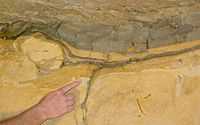
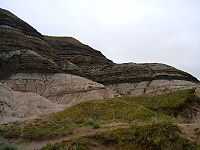
In the image on the right, the finger is pointing to the K/Pg boundary clay in the Geulhemmergroeve tunnels near Geulhem, The Netherlands.
The second from the top image on the right shows the K-Pg boundary in the Badlands near Drumheller, Alberta, where glacial and post-glacial erosion have exposed the boundary.
The cliffs at Stevns, in the image at the top of this page, have the highest iridium occurrence in the Alvarez analysis.
The K-Pg boundary at Trinidad Lake State Park, Colorado, USA, in the fourth image on the right, occurs at the color change from dark gray or black to the Cenozoic light tans and browns.
"Our assessment of published radiometric dates suggests the following best biochronologic age estimates for Cenozoic Epoch boundaries: Pliocene/Pleistocene: <2 Ma; Miocene/Pliocene: ~5 Ma; Oligocene/Miocene: ~23.5 Ma; Eocene/Oligocene: ~37 Ma; Paleocene/Eocene: ~56.5 Ma; Cretaceous/Tertiary: ~66 Ma. The radiometric data on which these age estimates are based, especially in the Paleogene, are biased toward those obtained from high-temperature minerals; age estimates based on radiometric dates from glauconites tend to be younger, particularly in the Paleogene (for example, Odin and others, 1982)."[6]
Quaternary
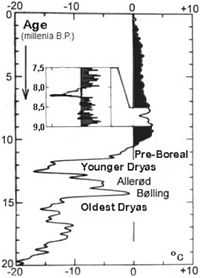
The "whole change elapsed just opposite the course of events that characterized the great glacial oscillations with sudden warming followed by slow cooling. Therefore, the two phenomena hardly have the same cause."[7]
"In the Greenland ice cores, the Pleistocene–Holocene transition is chronologically constrained between two clearly defined tephra horizons: the Saksunarvatn tephra (1409.83 m depth) and the Vedde Ash (1506.14 m depth). These are dated at 10 347 yr b2 k (counting uncertainty 89 yr) and 12 171 yr (counting uncertainty 114 yr) b2 k, respectively."[1]
Holocene
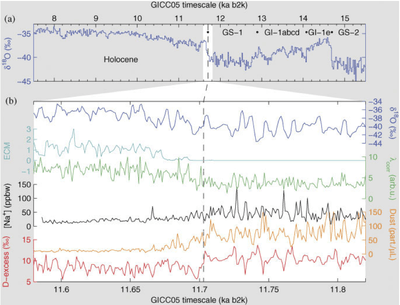
The Holocene starts at ~11,700 b2k and extends to the present.
"A timescale based on multi-parameter annual layer counting provides an age of 11 700 calendar yr b2k (before AD 2000) for the base of the Holocene, with a maximum counting error of 99 yr."[1]
"The base of the Holocene Series/Epoch is defined in the NGRIP ice-core record [above] at the horizon which shows the clearest signal of climatic warming, an event that marks the end of the last cold episode (Younger Dryas Stadial/Greenland Stadial 1) of the Pleistocene [...]."[1]
Recent history
The recent history period dates from around 1,000 b2k to present.
Classical history
The classical history period dates from around 2,000 to 1,000 b2k.
Early history
The early history period dates from around 3,000 to 2,000 b2k.
Subatlantic history
The "calibration of radiocarbon dates at approximately 2500-2450 BP [2500-2450 b2k] is problematic due to a "plateau" (known as the "Hallstatt-plateau") in the calibration curve [...] A decrease in solar activity caused an increase in production of 14C, and thus a sharp rise in Δ 14C, beginning at approximately 850 cal (calendar years) BC [...] Between approximately 760 and 420 cal BC (corresponding to 2500-2425 BP [2500-2425 b2k]), the concentration of 14C returned to "normal" values."[8]
Subboreal history
The "period around 850-760 BC, [2850-2760 b2k, is] characterised by a decrease in solar activity and a sharp increase of Δ 14C [...] the local vegetation succession, in relation to the changes in atmospheric radiocarbon content, shows additional evidence for solar forcing of climate change at the Subboreal - Subatlantic transition."[8]
Iron Age
World-wide production and use of iron began between 3,200 and 2,100 b2k.
Ancient history
The ancient history period dates from around 8,000 to 3,000 b2k.
Bronze Age
A general world-wide use of bronze occurred between 5300 and 2600 b2k.
Atlantic history
The Atlantic period [is from] 4.6–6 ka [6,000 to 4,600 b2k].[9]
Boreal transition
"In some cores a narrow band of clay interrupts the organic muds, at the horizon of the Boreal Atlantic transition."[10]
Chalcolithic
The Chalcolithic is often referred to as the Copper Age.
The "oldest securely dated evidence of copper making, from 7,000 years ago [6990 b2k], at the archaeological site of Belovode, Serbia."[11]
Pre-Boreal transition
"The Pre-boreal period marks the transition from the cold climate of the Late-glacial to the warmer climate of Post-glacial time. This change is immediately obvious in the field from the nature of the sediments, changing as they do from clays to organic lake muds, showing that at this time a more or less continuous vegetation cover was developing."[10]
"At the beginning of the Pre-boreal the pollen curves of the herbaceous species have high values, and most of the genera associated with the Late-glacial fiora are still present e.g. Artemisia, Polemomium and Thalictrum. These plants become less abundant throughout the Pre-boreal, and before the beginning of the Boreal their curves have reached low values."[10]
Neolithic
The base of the Neolithic is approximated to 12,200 b2k, The transition to the Chalcolithic is between 6,500 and 4,000 b2k.
Mesolithic
The mesolithic period dates from around 13,000 to 8,500 b2k.
Paleolithic
The paleolithic period dates from around 2.6 x 106 b2k to the end of the Pleistocene around 12,000 b2k.
Prehistory
The prehistory period dates from around 7 x 106 b2k to about 7,000 b2k.
Pleistocene
People appear.
Younger Dryas
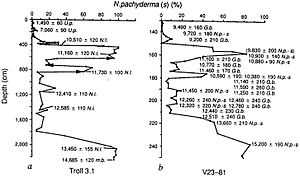
"The Younger Dryas interval during the Last Glacial Termination was an abrupt return to glacial-like conditions punctuating the transition to a warmer, interglacial climate."[12]
"From former cirque glaciers in western Norway, it is calculated that the summer (1.May to 30.September) temperature dropped 5-6°C during less than two centuries, probably within decades, at the Alleröd/Younger Dryas transition, some 11,000 years ago."[13]
Allerød Oscillation
"During the Allerød Chronozone, 11,800 to 11,000 years ago, western Europe approached the present day environmental and climatic situation, after having suffered the last glacial maximum some 20,000 to 18,000 years ago. However, the climatic deterioration 11,000 years ago led to nearly fully glacial conditions on this continent for some few hundreds of years during the Younger Dryas. This change is completely out of phase with the Milankovitch (orbital) forcing as this is understood today, and therefore its cause is of major interest."[13]
"Excess 14C in Cariaco Basin sediments indicates a slowing in thermohaline circulation and heat transport to the North Atlantic at that time, and both marine and terrestrial paleoclimate proxy records around the North Atlantic show a short-lived (<400 yr) cold event (Intra-Allerød cold period) that began ca. 13,350 yr B.P."[14]
Older Dryas
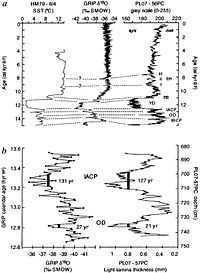
"The most negative δ 18O excursions seen in the GRIP record lasted approximately 131 and 21 years for the [inter-Allerød cold period] IACP and [Older Dryas] OD, respectively. The comparable events in the Cariaco basin were of similar duration, 127 and 21 years. In addition to the chronological agreement, there is also considerable similarity in the decade-scale patterns of variability in both records. Given the geographical distance separating central Greenland from the southern Caribbean Sea, the close match of the pattern and duration of decadal events between the two records is striking."[15]
In the figures on the right, especially b, is a detailed "comparison of δ 18O from the GRIP ice core24 with changes in a continuous sequence of light-lamina thickness measurements from core PL07-57PC. Both records are constrained by annual chronologies, although neither record is sampled at annual resolution. The interval of comparison includes the inter-Allerød cold period (12.9-13 cal. kyr BP) and Older Dryas (13.4 cal. kyr BP) events (IABP and OD from a). The durations of the two events, measured independently in both records, are very similar, as is the detailed pattern of variability at the decadal timescale."[15]
Bølling Oscillation
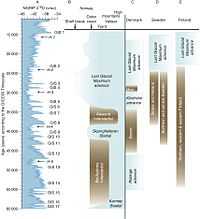
The "intra-Bølling cold period [IBCP is a century-scale cold event and the] Bølling warming [occurs] at 14600 cal [calendar years] BP (12700 14C BP)".[16]
The "Bølling was originally defined as starting from 13000 14C BP (calibrated to ~15650 cal BP; Stuiver et al., 1998). [...] independent annual chronology indicate a much later onset of the Bølling (e.g., 14600 cal BP".[16]
"During the IBCP and perhaps also IACP, δ 18O values inversely correlate with δ 13C, but during the OD δ 18O shows positive correlation with δ 13C, suggesting dry conditions with high evaporation, as well as cold."[16]
The Bølling interstadial corresponds to GIS 1 as shown in the diagram on the right.[17]
Oldest Dryas
"The synchronous and nearly uniform lowering of snowlines in Southern Hemisphere middle-latitude mountains compared with Northern Hemisphere values suggests global cooling of about the same magnitude in both hemispheres at the [Last Glacial Maximum] LGM. When compared with paleoclimate records from the North Atlantic region, the middle-latitude Southern Hemisphere terrestrial data imply interhemispheric symmetry of the structure and timing of the last glacial/interglacial transition. In both regions atmospheric warming pulses are implicated near the beginning of Oldest Dryas time (~14,600 14C yr BP) and near the Oldest Dryas/Bølling transition (~12,700-13,000 14C yr BP). The second of these warming pulses was coincident with resumption of North Atlantic thermohaline circulation similar to that of the modern mode, with strong formation of Lower North Atlantic Deep Water in the Nordic Seas. In both regions, the maximum Bølling-age warmth was achieved at 12,200-12,500 14C yr BP, and was followed by a reversal in climate trend. In the North Atlantic region, and possibly in middle latitudes of the Southern Hemisphere, this reversal culminated in a Younger-Dryas-age cold pulse."[18]
Jylland stade
"After c. 22 ka BP during the Jylland stade (Houmark-Nielsen 1989), Late Weichselian glaciers of the Main Weichselain advance overrode Southeast Denmark from the northeast and later the Young Baltic ice invaded from southeasterly directions. Traces of the Northeast-ice are apparently absent in the Klintholm sections, although large scale glaciotectonic structures and till deposits from this advance are found in Hjelm Bugt and Møns Klint (Aber 1979; Berthelsen 1981, 1986). At Klintholm, the younger phase of glaciotectonic deformation from the southeast and south and deposition of the discordant till (unit 9) were most probably associated with recessional phases of the Young Baltic glaciation. In several cliff sections, well preserved Late Glacial (c. 14-10 ka BP) lacustrine sequences are present (Kolstrup 1982, Heiberg 1991)."[19]
GIS 2
The weak interstadial corresponding to GIS 2 occurred about 23.2 kyr B.P.[17]
GIS 3
The stronger GIS 3 interstadial occurred about 27.6 kyr B.P.[17]
Møn interstadial
The Møn interstadial corresponds to GIS 4.[17]
Klintholm advance
This advance occurred after the Møn and ended with GIS 6.[17]
GIS 5
GIS 5 interstadial occurred during the Klintholm advance about 33.5 kyr B.P.[17]
Ålesund Interstadial
The Ålesund interstadial began with GIS 6 and ended after GIS 8.[17]
Huneborg interstadial
The Huneborg interstadial is a Greenland interstadial dating 36.5-38.5 kyr B.P. GIS 8.[17]
Hengelo interstadial
The Hengelo interstadial [is] > 35 ka BP".[19]
"An evolution with the coldest phases (coarsest grains) between 27,000 and 10,000 years B.P., 52,000 and 34,000 years B.P., and 76,000 and 60,000 years B.P. and relatively warmer intervals (finer grain size) in between is obvious. Apparently, they reflect a 21,000-year periodicity. This trend is superposed by much shorter oscillations of a duration of one to a few thousand years. Their duration is similar to the Dansgaard-Oeschger oscillations in the ice-core records. Some well-defined stadials and interstadials from the terrestrial records show also such a duration: for instance, the Hengelo interstadial around 37-38,500 14C years B.P. (Zagwijn, 1974; Kasse et al., 1995) and the preceding Hasselo stadial at approximately 40-38,500 14C years B.P. (Van Huissteden, 1990)."[20]
Hasselo stadial
The "Hasselo stadial [is] at approximately 40-38,500 14C years B.P. (Van Huissteden, 1990)."[20]
"One of two strongly rounded fragments of the mammoth maxilla from the Shapka Quarry in the southern Leningrad region was recently dated at 38450 + 400/–300 years (GrA-39 116) and rhinoceros remains (spoke bone), back to 38360 + 300/–270 years ago (GrA-38 819) [7]. The maxilla fragments occurred in sediments of the Leningrad Interstadial, which correspond to the transition between the Hasselo Stadial (44–39 ka ago) and the Hengelo Interstadial (38–36 ka ago)."[21]
The Hasselo stadial corresponds to the Skjonghelleren stadial in Norway but to the Sejrø interstadial in Denmark.[17]
Moershoofd interstadial
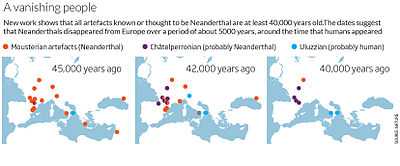
The Moershoofd interstadial has a 14C date of 44-46 kyr B.P. and corresponds to GIS 12 at 45-47 kyr B.P.[17]
Glinde interstadial
The Glinde interstadial has a 14C date of 48-50 kyr B.P. and corresponds to GIS ?13/14 with a GIS age of 49-54.5 kyr B.P.[17]
Oerel interstadial
The Oerel interstadial has a 14C date of 53-58 kyr B.P. and corresponds to GIS 15/16 with a GIS age of 56-59 kyr B.P.[17]
Karmøy stadial
The Karmøy stadial begins in the high mountains of Norway about 58 kyr B.P. and expands to the outer coast by 60 kyr B.P.[17]
Odderade interstadial
The Odderade interstadial has a 14C date of 61-72 kyr B.P. and corresponds to GIS 21.[17]
Brørup interstadial
The "Brørup interstade [is about] 100 ka BP".[19] It corresponds to GIS 23/24.[17]
Aftonian
"The age of the [ stag moose Cervalces] roosevelti type specimen is pre-Wisconsin (Aftonian)".[22]
"Clay deposition in the Piauí River floodplain around 436 ± 51.5 ka occurred during a warmer period of the Aftonian interglaciation, corresponding to isotope stage 12 (Ericson and Wollin, 1968)."[23]
Calabrian
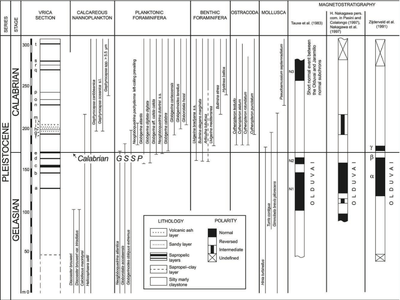
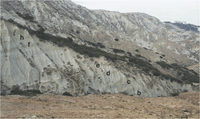
"The [Calabrian] GSSP occurs at the base of the marine claystone conformably overlying sapropelic bed ‘e’ within Segment B in the Vrica section. This lithological level represents the primary marker for the recognition of the boundary, and is assigned an astronomical age of 1.80 Ma on the basis of sapropel calibration."[24]
"The boundary falls between the highest occurrence of Discoaster brouweri (below) and the lowest common occurrence of left-coiling Neogloboquadrina pachyderma (above), and below the lowest occurrences of medium-sized Gephyrocapsa (including G. oceanica) and Globigerinoides tenellus."[24]
In the image on the right, the Vrica section includes specifically the GSSP of the Calabrian Stage fixed at the top of layer ‘e’.
Gelasian

"The base of the Quaternary System [shown in the image on the right] is defined by the Global Stratotype Section and Point (GSSP) of the Gelasian Stage at Monte San Nicola in Sicily, Italy, currently dated at 2.58 Ma."[25]
"The astrochronological age of sapropel MPRS 250 (mid-point), corresponding to precessional cycle 250 from the present, is 2.588 Ma (Lourens et al., 1996), which can be assumed as the age of the boundary."[26]
Neogene
The Neogene dates from 23.03 x 106 to 2.58 x 106 b2k.
Pliocene
The Pliocene ranges from 5.332 x 106 to 2.588 x 106 b2k.
"All of Pliocene time, without a gap, is physically represented in the three stages of which it is composed, in a single demonstrably uninterrupted sequence of highly fossiliferous Upper Cenozoic deep-water strata on the southern coast of Sicily. From bottom to top, the Pliocene consists of the Lower Pliocene Zanclean Stage, with a boundary-stratotype at Eraclea Minoa and a unit-stratotype at Capo Rossello; the Middle Pliocene Piacenzian Stage, defined at Punta Piccola (Castradori et al., 1998); and the Upper Pliocene Gelasian Stage, defined at Monte San Nicola near Gela (Rio et al., 1994, 1998) [...]."[27]
"The base of the Quaternary System is defined by the Global Stratotype Section and Point (GSSP) of the Gelasian Stage at Monte San Nicola in Sicily, Italy, currently dated at 2.58 Ma."[25]
Piacenzian
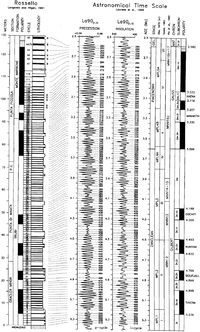
"The base of the beige marl bed of the small-scale carbonate cycle 77 (sensu Hilgen, 1991b) is the approved base of the Piacenzian Stage (that is the Lower Pliocene-Middle Pliocene boundary). It corresponds to precessional excursion 347 as numbered from the present with an astrochronological age estimate of 3.600 Ma (Lourens et al., 1996a)."[28]
Zanclean
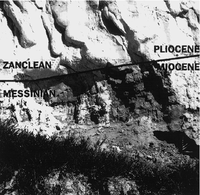
"The boundary-stratotype of the stage is located in the Eraclea Minoa section on the southern coast of Sicily (Italy), at the base of the Trubi Formation. The age of the Zanclean and Pliocene GSSP at the base of the stage is 5.33 Ma in the orbitally calibrated time scale, and lies within the lowermost reversed episode of the Gilbert Chron (C3n.4r), below the Thvera normal subchron."[27]
In the chronostratigraphic correlation in the Piacenzian section, the base of the Zanclean is marked as the '0' point.
Miocene
The Miocene dates from 23.03 x 106 to 5.332 x 106 b2k.
Paleogene
The Paleogene Period extends from 65.5 ± 0.3 to 23.03 ± 0.05 x 106 b2k.[29]
Oligocene
The Oligocene dates from 33.9 ± 0.1 x 106 to 23.03 x 106 b2k.
The Oligocene Epoch covers 34 - 23 Mya.[30]
Eocene
The Eocene dates from 55.8 ± 0.2 x 106 to 33.9 ± 0.1 x 106 b2k.
Paleocene
The Paleocene dates from 65.5 ± 0.3 x 106 to 55.8 ± 0.2 x 106 b2k.
Danian
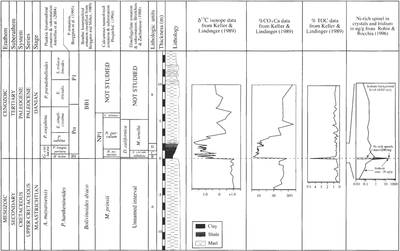
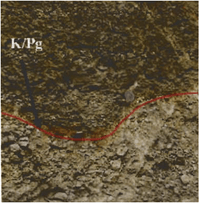
"Many correlation criteria are present at the GSSP of which the most useful are the meteorite impact evidence (iridium anomaly, Ni-rich spinel, etc.) and the mass extinction of plankic micro- and nannofossils."[31]
The "GSSP of the K/Pg boundary [is defined] at the base of the boundary clay at the section near El Kef, Tunisia."[31]
"The section [specifically shown in a closeup on the right] contains marine sediments and sedimentation was as continuous as it could be at a K/Pg boundary. There is a facies change from a grey marl to a black clay (Boundary Clay), at the base of which is a thin rusty layer. This is the fingerprint of continuous sedimentation over the K/Pg boundary interval."[31]
"Neither magnetostratigraphy nor geochronometry are available at the section near El Kef."[31]
"The GSSP section near El Kef contains one main feature that allows for a direct correlation of this marine section with continental sections: the Ir anomaly at the base of the Boundary Clay."[31]
The Global Boundary Stratotype Section and Point for the base of the Danian Stage is also the base GSSP for the Paleocene, Paleogene, "Tertiary", and Cenozoic at El Kef, Tunisia.
Research
Hypothesis:
- Each time frame or span of time in the geochronology of the Cenozoic has at least one dating technique.
Control groups

The findings demonstrate a statistically systematic change from the status quo or the control group.
“In the design of experiments, treatments [or special properties or characteristics] are applied to [or observed in] experimental units in the treatment group(s).[32] In comparative experiments, members of the complementary group, the control group, receive either no treatment or a standard treatment.[33]"[34]
Proof of concept
Def. a “short and/or incomplete realization of a certain method or idea to demonstrate its feasibility"[35] is called a proof of concept.
Def. evidence that demonstrates that a concept is possible is called proof of concept.
The proof-of-concept structure consists of
- background,
- procedures,
- findings, and
- interpretation.[36]
See also
References
- 1 2 3 4 Mike Walker, Sigfus Johnsen, Sune Olander Rasmussen, Trevor Popp, Jørgen-Peder Steffensen, Phil Gibbard, Wim Hoek, John Lowe, John Andrews, Svante Björck, Les C. Cwynar, Konrad Hughen, Peter Kershaw, Bernd Kromer, Thomas Litt, David J. Lowe, Takeshi Nakagawa, Rewi Newnham and Jakob Schwander (2009). "Formal definition and dating of the GSSP (Global Stratotype Section and Point) for the base of the Holocene using the Greenland NGRIP ice core, and selected auxiliary records". Journal of Quaternary Science 24 (1): 3-17. doi:10.1002/jqs.1227. http://www.stratigraphy.org/GSSP/Holocene.pdf. Retrieved 2015-01-18.
- ↑ Names from local versions of the geologic timescale can often be found in the local language. The English name is usually found by replacing the suffix in the local language for -an or -ian. Examples for "local" suffices are -en (French), -ano (Spanish), -ium (German), -aidd (Welsh) or -aan (Flemish Dutch). The English name "Norian", for example, becomes Noriano in Spanish, Norium in German, Noraidd in Welsh or Norien in French.
- 1 2 Time is given in Megaannum (million years BP, unless other units are given in the table. BP stands for "years before present". For ICS-units the absolute ages are taken from Gradstein et al. (2004).
- ↑ Hohenegger, Johann; Ćorić, Stjepan; Wagreich, Michael (2014). "Timing of the Middle Miocene Badenian Stage of the Central Paratethys". Geologica Carpathica 65 (1). doi:10.2478/geoca-2014-0004. http://geologie.univie.ac.at/uploads/media/Hohenegger.etal.Badenian.age.2014.GC_1_.pdf.
- ↑ The status of the Tertiary is not yet decided. The ICS will probably make a decision in 2009.
- ↑ William A. Berggren, Dennis V. Kent, John J. Flynn, and John A. Van Couvering (November 1985). "Cenozoic geochronology". Geological Society of America Bulletin 96 (11): 1407-18. doi:10.1130/0016-7606(1985)96<1407:CG>2.0.CO;2. http://academiccommons.columbia.edu/download/fedora_content/download/ac:143432/CONTENT/gsab.96.11.1407.full.pdf. Retrieved 2015-09-16.
- ↑ Willi Dansgaard (2005). The Department of Geophysics of The Niels Bohr Institute for Astronomy, Physics and Geophysics at The University of Copenhagen, Denmark. ed. Frozen Annals Greenland Ice Cap Research. Copenhagen, Denmark: Niels Bohr Institute. pp. 123. ISBN 87-990078-0-0. http://www.iceandclimate.nbi.ku.dk/publications/FrozenAnnals.pdf/. Retrieved 2014-10-05.
- 1 2 A. Speranza, J. van der Plicht, and B. van Geel (November 2000). "Improving the time control of the Subboreal/Subatlantic transition in a Czech peat sequence by 14C wiggle-matching". Quaternary Science Reviews 19 (16): 1589-1604. doi:10.1016/S0277-3791(99)00108-0. http://www.researchgate.net/publication/30494985_Improving_the_time_control_of_the_SubborealSubatlantic_transition_in_a_Czech_peat_sequence_by_14C_wiggle-matching/file/60b7d51c350cf2efa0.pdf. Retrieved 2014-11-04.
- ↑ E.B. Karabanov, A.A. Prokopenko, D.F. Williams, and G.K. Khursevich (March 2000). "A new record of Holocene climate change from the bottom sediments of Lake Baikal". Palaeogeography, Palaeoclimatology, Palaeoecology 156 (3-4): 211–24. doi:10.1016/S0031-0182(99)00141-8. http://www.sciencedirect.com/science/article/pii/S0031018299001418. Retrieved 2014-11-04.
- 1 2 3 J. W. Franks and W. Pennington (April 1961). "The Late-Glacial and Post-Glacial Deposits of the Esthwaite Basin, North Lancashire". New Phytologist 60 (1): 27-42. http://onlinelibrary.wiley.com/store/10.1111/j.1469-8137.1961.tb06237.x/asset/j.1469-8137.1961.tb06237.x.pdf;jsessionid=EB6966DF0A2FBCC3534CCD6A6413808D.f02t01?v=1&t=i23es9k1&s=e619673cf5bc8be51450a303a914df03f8cba94d. Retrieved 2014-11-04.
- ↑ Miljana Radivojevic and Thilo Rehren (23 September 2010). "Serbian site may have hosted first copper makers". 31-34 Gordon Square - London - WC1H 0PY England: UCL Institute of Archaeology. Retrieved 2015-01-18.
- ↑ R. Muscheler, B. Kromer, S. Björck, A. Svensson, M. Friedrich, K. F. Kaiser, & J. Southon (2008). "Tree rings and ice cores reveal 14C calibration uncertainties during the Younger Dryas". Nature Geoscience 1 (4): 263-7. doi:10.1038/ngeo128. http://www.nature.com/ngeo/journal/v1/n4/full/ngeo128.html. Retrieved 2014-10-09.
- 1 2 Jan Mangerud (1987). W. H. Berger and L. D. Labeyrie. ed. The Alleröd/Younger Dryas Boundary, In: Abrupt Climatic Change. D. Reidel Publishing Company. pp. 163-71. http://folk.uib.no/ngljm/PDF_files/Mangerud%201987,YD%20boundary.PDF. Retrieved 2014-11-03.
- ↑ Jeffrey P. Donnelly, Neal W. Driscoll, Elazar Uchupi, Lloyd D. Keigwin, William C. Schwab, E. Robert Thieler and Stephen A. Swift (February 2005). "Catastrophic meltwater discharge down the Hudson Valley: A potential trigger for the Intra-Allerød cold period". Geology 33 (2): 89-92. doi:10.1130/G21043.1. http://geology.geoscienceworld.org/content/33/2/89.abstract. Retrieved 2014-11-04.
- 1 2 Konrad A. Hughes, Jonathan T. Overpeck, Larry C. Peterson & Susan Trumbore (7 March 1996). Rapid climate changes in the tropical Atlantic region during the last deglaciation. 380. pp. 51-4. http://www.diagonalarida.cl/SemV/Hughen_etal_1996_tropicalAtlantic.pdf. Retrieved 2014-11-05.
- 1 2 3 Zicheng Yu and Ulrich Eicher (2001). "Three Amphi-Atlantic Century-Scale Cold Events during the Bølling-Allerød Warm Period". Géographie physique et Quaternaire 55 (2): 171-9. doi:10.7202/008301ar. http://www.lehigh.edu/~ziy2/pubs/YuGpQPreprint.pdf. Retrieved 2014-11-04.
- 1 2 3 4 5 6 7 8 9 10 11 12 13 14 15 Barbara Wohlfarth (April 2010). "Ice-free conditions in Sweden during Marine Oxygen Isotope Stage 3?". Boreas 39: 377-98. doi:10.1111/j.1502-3885.2009.00137.x. http://people.su.se/~wohlf/pdf/Wohlfarth%20Boreas%202010.pdf. Retrieved 2014-11-06.
- ↑ George H. Denton, Thomas V. Lowell, Calvin J. Heusser, Patricio I. Moreno, Bjørn G. Andersen, Linda E. Heusser, Christian Schlüchter, David R. Marchant (1999). "Interhemispheric Linkage of Paleoclimate during the Last Glaciation". Geografiska Annaler. Series A, Physical Geography 81A (2): 107-53. http://people.bu.edu/marchant/Dave_FullText_Papers/Denton_GA_1999.pdf. Retrieved 2014-11-05.
- 1 2 3 Michael Houmark-Nielsen, (30 November 1994). "Late Pleistocene stratigraphy, glaciation chronology and Middle Weichselian environmental history from Klintholm, Møn, Denmark". Bulletin of the Geological Society of Denmark 41 (2): 181-202. http://2dgf.dk/xpdf/bull41-02-181-202.pdf. Retrieved 2014-11-03.
- 1 2 J. Vandenberghe and G. Nugteren (2001). "Rapid climatic changes recorded in loess successions". Global and Planetary Change 28 (1-9): 222-30. http://shixi.bnu.edu.cn/field-trips/cooperation/ChinaSweden/the%20link/1.1.4.pdf. Retrieved 2014-11-06.
- ↑ A.A. Nikonov, M.M. Shakhnovich, J. van der Plicht (2011). "Age of Mammoth Remains from the Submoraine Sediments of the Kola Peninsula and Karelia". Doklady Earth Sciences 436 (2): 308-10. http://cio.eldoc.ub.rug.nl/FILES/root/2011/DoklEarthSciNikonov/2011DoklEarthSciNikonov.pdf?origin=publication_detail. Retrieved 2014-11-06.
- ↑ Chris Widga, Tara L. Fulton, Larry D. Martin and Beth Shapiro (October 2012). "Homotherium serum and Cervalces from the Great Lakes Region, USA: geochronology, morphology and ancient DNA". Boreas 41 (4): 547-56. doi:1111/j.1502-3885.2012.00267.x. http://pgl.soe.ucsc.edu/widga12.pdf. Retrieved 2015-01-20.
- ↑ Janaina C. Santos; Alcina Magnólia Franca BarretoII; Kenitiro Suguio (16 August 2012). "Quaternary deposits in the Serra da Capivara National Park and surrounding area, Southeastern Piauí state, Brazil". Geologia USP. Série Científica 12 (3). doi:10.5327/Z1519-874X2012000300008. http://ppegeo.igc.usp.br/scielo.php?pid=S1519-874X2012000300009&script=sci_arttext. Retrieved 2015-01-20.
- 1 2 Maria Bianca Cita, Philip L. Gibbard, Martin J. Head, and the ICS Subcommission on Quaternary Stratigraphy (September 2012). "Formal ratification of the GSSP for the base of the Calabrian Stage (second stage of the Pleistocene Series, Quaternary System)". Episodes 35 (3): 388-97. http://www.stratigraphy.org/GSSP/Calabrian2.pdf. Retrieved 2015-01-18.
- 1 2 Philip L. Gibbard and Martin J. Head (September 2010). "The newly-ratified definition of the Quaternary System/Period and redefinition of the Pleistocene Series/Epoch, and comparison of proposals advanced prior to formal ratification". Episodes 33 (3): 152-8. http://www.stratigraphy.org/GSSP/Quaternary&Pleistocene.pdf. Retrieved 2015-01-20.
- ↑ D. Rio, R. Sprovieri, D. Castradori, and E. Di Stefano (June 1998). "The Gelasian Stage (Upper Pliocene): A new unit of the global standard chronostratigraphic scale". Episodes 21 (2): 82-7. http://www.stratigraphy.org/GSSP/Gelasian.pdf. Retrieved 2015-01-20.
- 1 2 John A. Van Couvering, Davide Castradori, Maria Bianca Cita, Frederik J. Hilgen, and Domenico Rio (September 2000). [http://www.stratigraphy.org/GSSP/Zanclean.pdf "The base of the Zanclean Stage and of the Pliocene Series"]. Episodes 23 (3): 179-87. http://www.stratigraphy.org/GSSP/Zanclean.pdf. Retrieved 2015-01-23.
- ↑ D. Castradori, D. Rio, F. J. Hilgen, and L. J. Lourens (June 1998). "The Global Standard Stratotype-section and Point (GSSP) of the Piacenzian Stage (Middle Pliocene)". Episodes 21 (2): 88-93. http://www.stratigraphy.org/GSSP/Piacenzian.pdf. Retrieved 2015-01-23.
- ↑ Robert A. Rohde (18 January 2005). "Paleogene Period". GeoWhen Database. Retrieved 2015-09-16.
- ↑ Gaidheal1 (April 13, 2011). Paleogene Period, In: Wikiversity. http://en.wikiversity.org/wiki/Paleogene_Period. Retrieved 2012-07-24.
- 1 2 3 4 5 Eustoquio Molina, Laia Alegret, Ignacio Arenillas, José A. Arz, Njoud Gallala, Jan Hardenbol, Katharina von Salis, Etienne Steurbaut, Noël Vandenberghe, and Dalila Zaghbib-Turki (December 2006). "The Global Boundary Stratotype Section and Point for the base of the Danian Stage (Paleocene, Paleogene, "Tertiary", Cenozoic) at El Kef, Tunisia - Original definition and revision". Episodes 29 (4): 263-73. http://www.stratigraphy.org/GSSP/Danian.pdf. Retrieved 2015-01-19.
- ↑ Klaus Hinkelmann, Oscar Kempthorne (2008). Design and Analysis of Experiments, Volume I: Introduction to Experimental Design (2nd ed.). Wiley. ISBN 978-0-471-72756-9. http://books.google.com/?id=T3wWj2kVYZgC&printsec=frontcover.
- ↑ R. A. Bailey (2008). Design of comparative experiments. Cambridge University Press. ISBN 978-0-521-68357-9. http://www.cambridge.org/uk/catalogue/catalogue.asp?isbn=9780521683579.
- ↑ "Treatment and control groups, In: Wikipedia". San Francisco, California: Wikimedia Foundation, Inc. May 18, 2012. Retrieved 2012-05-31.
- ↑ "proof of concept, In: Wiktionary". San Francisco, California: Wikimedia Foundation, Inc. November 10, 2012. Retrieved 2013-01-13.
- ↑ Ginger Lehrman and Ian B Hogue, Sarah Palmer, Cheryl Jennings, Celsa A Spina, Ann Wiegand, Alan L Landay, Robert W Coombs, Douglas D Richman, John W Mellors, John M Coffin, Ronald J Bosch, David M Margolis (August 13, 2005). "Depletion of latent HIV-1 infection in vivo: a proof-of-concept study". Lancet 366 (9485): 549-55. doi:10.1016/S0140-6736(05)67098-5. http://www.ncbi.nlm.nih.gov/pmc/articles/PMC1894952/. Retrieved 2012-05-09.
External links
- GeoWhen Database
- Global Boundary Stratotype Section and Point (GSSP) of the International Commission on Stratigraphy
| |||||||||||||||||||||||||||||||||||
![]() This is a research project at http://en.wikiversity.org
This is a research project at http://en.wikiversity.org
| |
Development status: this resource is experimental in nature. |
| |
Resource type: this resource is an article. |
| |
Resource type: this resource contains a lecture or lecture notes. |
| |
Educational level: this is a research resource. |
| |
Subject classification: this is a Geology resource. |